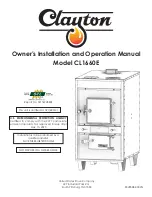
SERVICING
45
Cooling Anticipator
The cooling anticipator is a small heater (resistor) in the ther-
mostat. During the "OFF" cycle it heats the bimetal element
helping the thermostat call for the next cooling cycle. This
prevents the room temperature from rising too high before
the system is restarted. A properly sized anticipator should
maintain room temperature within 1 1/2 to 2 degrees.
The anticipator is fixed in the subbase and is not to be
replaced. If the anticipator should fail for any reason, the
subbase must be changed.
S-4 CHECKING TRANSFORMER AND Control CIR-
CUIT
A step-down transformer 120 volt primary to 24 volt second-
ary, 40 VA (Heating and Cooling Models) supplies ample
capacity of power for either operation.
WARNING
HIGH
VOLTAGE
D
ISCONNECT
ALL
POWER BEFORE SERVICING OR
CHANGING ANY ELECTRICAL WIRING.
M
ULTIPLE POWER
SOURCES MAY BE PRESENT.
F
AILURE TO DO SO MAY CAUSE
PROPERTY DAMAGE, PERSONAL INJURY OR DEATH.
1. Remove blower compartment door to gain access to
the thermostat low voltage wires located at the furnace
integrated control module.
2. Remove the thermostat low voltage wires at the furnace
integrated control module terminals.
With Power On (and Door Interlock Switch closed):
L
INE VOLTAGE NOW PRESENT
WARNING
3. Use a voltmeter, check voltage across terminals R and
C. Must read 24 VAC.
4. No voltage indicates faulty transformer, open fuse, bad
wiring, bad splice, or open door interlock switch.
5. Check transformer primary voltage at incoming line
voltage connections, fuse, splices, and blower door
interlock switch.
6. If line voltage is available to the primary side of trans-
former and not at secondary side, the transformer is
inoperative. Replace.
7. After completing check and/or replacement of trans-
former and check and/or repair of control circuit, rein-
stall blower compartment door.
8. Turn on electrical power and verify proper unit opera-
tion.
S-16 CHECKING AIR CIRCULATOR BLOWER MO-
TOR
D
ISCONNECT
ALL
POWER BEFORE SERVICING.
WARNING
1. Remove blower compartment door to gain access to the
circulator blower motor and integrated ignition control.
2. Disconnect the motor wire leads from its connection point
at the integrated ignition control module and capacitor if
applicable.
3. Using a ohmmeter, test for continuity between each of
the motor leads.
4. Touch one probe of the ohmmeter to the motor frame
(ground) and the other probe in turn to each lead.
If the windings do not test continuous or a reading is obtained
to ground, replace the motor.
5. After completing check and/or replacement of circulator
blower motor or induced draft blower motor, reinstall
blower compartment door.
6. Turn on electrical power and verify proper unit operation.
D
ISCONNECT
ALL
POWER BEFORE SERVICING.
WARNING
S-200
CHECKING DUCT STATIC
The maximum and minimum allowable external static pres-
sures are found in the specification section. These tables
also show the amount of air being delivered at a given static
by a given motor speed or pulley adjustment.
The furnace motor cannot deliver proper air quantities (CFM)
against statics other than those listed.
Too great of an external static pressure will result in insuffi
-
cient air that can cause excessive temperature rise, resulting
in limit tripping, etc. Whereas not enough static may result
in motor overloading.
To determine proper air movement, proceed as follows:
1. With clean filters in the furnace, use a draft gauge (inclined
manometer) to measure the static pressure of the return
duct at the inlet of the furnace. (Negative Pressure)
2. Measure the static pressure of the supply duct. (Positive
Pressure)
3. Add the two (2) readings together for total external static
pressure.
NOTE:
Both readings may be taken simultaneously and read
directly on the manometer if so desired. If an air conditioner
coil or Electronic Air Cleaner is used in conjunction with the
furnace, the readings must also include theses components,
as shown in the following drawing.
4. Consult proper tables for the quantity of air.














































